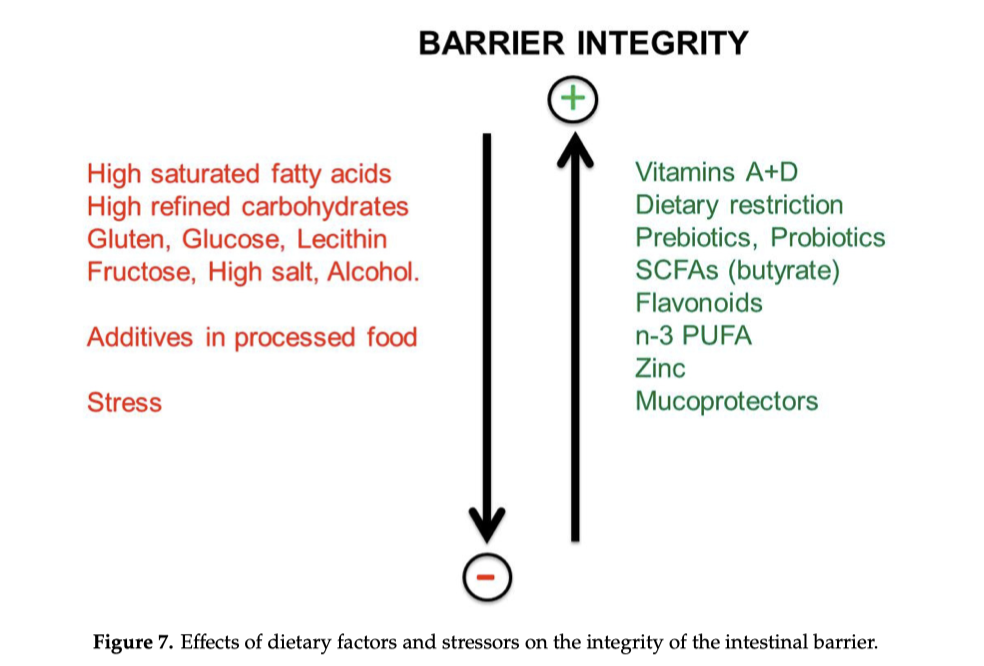Note riassuntive punti salienti delle ricerche sull’argomento trattato
Premessa (il percorso del cibo: cenni)
Il cibo ingerito inizia il suo percorso nella bocca dove inizia la digestione degli amidi, prosegue nello stomaco dove le proteine vengono scomposte in elementi più piccoli. Passa poi, nell’intestino dove altri enzimi digestivi continuano la digestione degli amidi, delle proteine e dei grassi. Nell’intestino la digestione continua per la presenza di altri enzimi e viene assimilato (l’assimilazione avviene principalmente nell’intestino tenue) attraverso i “villi” che ricoprono le pareti dell’intestino stesso; i nutrienti che attraversano i villi entrano nel circolo sanguigno. Solo il cibo digerito può passare attraverso questa barriera intestinale. In un individuo sano, il cibo (di un pasto equlibrato, sano contenuto non digerito attraversa il colon per poi essere espulso. La funzione del colon è quella di assorbire acqua, nutrienti e di fermentare il cibo non digerito, convertendolo infine nelle feci per l’eliminazione.
8.1. La barriera fisica intestinale
La barriera fisica intestinale è costituita da uno strato (intestino tenue) o da due strati (intestino crasso) di muco, un singolo strato di cellule epiteliali e l’endotelio vascolare[1].
Le cellule epiteliali rappresentano la vera barriera insormontabile a tutte quelle molecole dannose per l’organismo. Ciò è reso possibile dal fatto le cellule epiteliali sono strettamente associate tra loro formando delle giunzioni strette (tight junction). La barriera epiteliale intestinale non è una struttura statica ma dinamica, poiché le sue giunzioni strette possono essere aperte e chiuse in risposta a stimoli esterni ed interni. Importanti regolatori dell’integrità della risposta epiteliale sono la zonulina e le proteine correlate alla zonulina. In presenza di un aumento di microbi nell’intestino tenue, l’attivazione della zonula apre le giunzioni strette lasciando passare molecole dannose (virus, batteri patogeni, parassiti, tossine, antigeni alimentari e cibo indigerito). La superficie esterna delle cellule epiteliali e anche protetta da uno strato di muco che limita il diretto contatto con i microbi. Si ritiene generalmente che l’integrità della barriera mucosa intestinale sia necessaria per evitare la diffusione sistemica dei batteri che popolano il nostro intestino, ma in realtà la ragione principale della presenza della barriera intestinale è impedire che le macromolecole alimentari entrino nel flusso sanguigno senza essere digerite.
Note:
[1]-L’endotelio vascolare è uno strato di cellule endoteliali che riveste la superficie interna dei vasi sanguigni, dei vasi linfatici e del cuore. Svolge un ruolo cruciale nella regolazione del flusso sanguigno, nella prevenzione della formazione di coaguli e nella comunicazione tra i vasi e i tessuti circostanti.
8.3. Perché la barriera intestinale è necessaria.
In conclusione, la barriera intestinale deve essere impermeabile principalmente alle molecole alimentari non completamente digerite. Ecco perché esiste. Anche la disseminazione microbica deve essere evitata, ma probabilmente non è questa la ragione per cui si è formata la barriera intestinale. La rottura della barriera consente sia alle molecole alimentari non digerite sia alle cellule microbiche di fuoriuscire dall’intestino ed entrare nel flusso sanguigno). Tutte queste condizioni possono innescare una risposta infiammatoria sistemica. Pertanto, la rottura della barriera intestinale deve essere assolutamente evitata.
9. Impatto delle abitudini alimentari sull’integrità della barriera intestinale
E’ sempre più evidente -dalle ricerche scientifiche- che la barriera intestinale deve rimanere integra per evitare le malattie gastrointestinali, autoimmuni ed altro (vedi approfondimento A). È quindi chiaro che è importante evitare o limitare alimenti e farmaci che possono allentare l’integrità della barriera intestinale comprese situazioni di stress persistenti e preferire i fattori dietetici che possono rafforzare l’integrità della barriera intestinale.
Poiché la disbiosi intestinale dipende principalmente dalle nostre abitudini alimentari e dal nostro stile di vita, siamo noi a causare l’infiammazione intestinale, l’apertura della barriera intestinale e le malattie metaboliche e croniche del nostro tempo. Tra queste è possibile associare alla disbiosi intestinale lo sviluppo di malattie neurodegenerative, che hanno una base infiammatoria.

